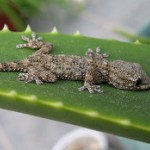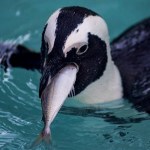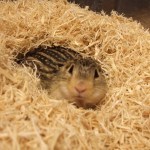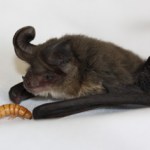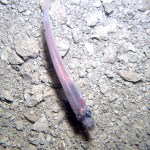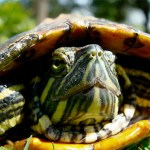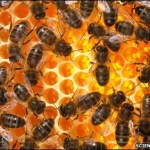
I was very impressed by the graduate and undergraduate students who presented their research at the Scholander poster competition sponsored by the Comparative and Evolutionary Physiology section of the American Physiological Society this afternoon. I am sure the winner of the competition will be very difficult to select.
Some highlights included:
Bridget Martinez, graduate student at the University of California - Merced whose research focused on hormonal changes that occur with fasting in elephant seal pups. In mammals, food deprivation leads to lower…
I am so excited about the Experimental Biology conference this year in Boston, MA! I have packed my bags, prepared my posters and am on my way to the airport. As usual there will be several seminars and poster sessions about various comparative physiology topics sponsored by the American Physiological Society that look really exciting. Can't wait!
To learn more about the meeting, visit the American Physiological Society's website dedicated to the conference.
#ExpBio
A new study demonstrates that the blue oxygen carrying haemocyanin pigment in the blood of an Antarctic octopus (Pareledone charcoti) protect the animals from freezing temperatures. In fact, when compared to other octopus species from warmer climates, they have up to 40% more haemocyanin. Dr. Michael Oellermann, lead study author from Alfred-Wegener-Institute, provided the following quote for a press release: "This is the first study providing clear evidence that the octopods’ blue blood pigment, haemocyanin, undergoes functional changes to improve the supply of oxygen to…
A new study published in the Journal of the Royal Society Interface from a team of researchers (University of the Sunshine Coast, James Cook University, University of Queensland, Australia, and the University of Oxford) described how geckos living in humid areas manage to stay dry.
The researchers used a scanning electron microscope to take a closer look at the skin of box-patterned geckos (Lucasium steindachneri), which is how they discovered the dense microscopic spiny hairs that are also found in other species of geckos. The hairs trap air and the tips of the hair help gather water into…
I had no idea that matchmaking was this complex for zoo animals:
World News Videos | US News Videos
Image from Wikimedia Commons, Author: Alvesgaspar
New research from the University of Lincoln, UK suggests that cats may prefer to find food using their eyes as opposed to their nose. The preference for vision vs. smell was tested in 6 cats placed in a maze that required cats to make decisions about which way to go based on either images or smells. The researchers observed that 4 out of 6 of the cats chose the visual as opposed to the smell cues to obtain their rewards (food). One cat showed a preference for using its nose, whereas one cat showed no clear …
I really never thought of spiders as being "pretty" until I came across these two new species of peacock spiders discovered in southeast Queensland, Australia by Madeline Girard (graduate student from the University of California, Berkeley, who is specializing in peacock spiders). Peacock spiders are not only beautiful, they also engage in elaborate dances during courtship.
According to a quote from Jürgen Otto (posted in Live Science), who was a co-author in the study, Skeletorus "looks dramatically different [from] all other peacock spiders known to date, making me think that this…
Image of penguin from http://birding.about.com/od/birdfeeders/fl/What-Do-Penguins-Eat.htm
Researchers sequencing the five different taste receptors in penguins were surprised to discover that the animals do not have genes that encode for receptors that are specific for savory meaty flavors (like fish!), sweet or bitter tastes. Instead, the data suggest that penguins are only able to taste the saltiness or sourness of their foods and also suggest that the birds may not be able to taste their fish dinner.
According to a quote from the lead study author Jianzhi George Zhang (University of…
Photo by: Leif Richardson, Dartmouth College
I came across this neat press release from the University of Massachusetts:
AMHERST, Mass. – Researchers studying the interaction between plants, pollinators and parasites report that in recent experiments, bees infected with a common intestinal parasite had reduced parasite levels in their guts after seven days if the bees also consumed natural toxins present in plant nectar.
In this early and most comprehensive study of its kind, researchers at the University of Massachusetts Amherst and Dartmouth College studied hundreds of eastern bumblebees…
Pictoral abstract showing the use of nanofibers from fish collagen in wound healing. Image from Zhou et al., 2015.
Researchers in China have discovered that collagen isolated from the skin of tilapia effectively reduce wound healing time in mice. The usefulness of collagen, a major structural protein found in connective tussues, in wound healing has been known. Using fish proteins instead of typical mammalian sources reduces the risk for potential pathogens.
Dr. Jiao Sun (Shanghai Jiaotong University School of Medicine) and colleagues isolated collagen from the skin of tilapia and…
Congratulations to Mallory Ballinger, a graduate student from the University of Minnesota-Duluth, who is the 2015 recipient of the Dr. Dolittle Travel Award! The purpose of this award is to recognize an outstanding graduate student or postdoctoral fellow involved in comparative and evolutionary research and to provide assistance for them to attend the annual American Physiological Society Experimental Biology meeting. The application process includes the submission of a blog entry based on their research. She will be presenting her research at the upcoming Experimental Biology…
Official New York City Subway Map
Dr. Christopher Mason (Weill Cornell Medical College, Manhatten, NY) decided to sequence DNA found in NY subway stations...468 of them to be precise. At each station, his research team collected DNA samples by swabbing the kiosks, turnstiles, benches, railings, trash cans as well as the subway cars.
Along with finding abundant Pseudomonas bacteria (also found on our skin) they discovered that the DNA at each of the stations reflected the amazing diversity of the local residents and what they were eating such as pizza, cucumbers, and chickpeas, which may…
Image of Gould's long-eared bat from http://www.wiresnr.org/Microbats.htmlImage by: Lib Ruytenberg
I came across a neat study published recently in the American Journal of Physiology - Regulatory, Integrative and Comparative Physiology which examined how bats arouse from hibernation, a period during which their body temperature and metabolism are low. To minimize the high energetic costs of warming up during arousal, bats use solar radiation or take advantage of fluctuations in the ambient temperatures (i.e. environmental).
Researchers studied hibernating long-eared bats (Nyctophilus…
A new study published in the Proceedings of the National Academy of Sciences shows that cone snails use a pretty neat tactic to capture prey. They release insulin to lower blood sugar (i.e. hypoglycemic shock), which immobilizes fish for an easy meal. The venomous insulin is molecularly different from molluscan insulin and was actually found to be similar to fish insulin.
Sources:
Safav-Hemami H, Gajewiak J, Karanth S, Robinson SD, Ueberheide B, Douglass AD, Schlegel A, Imperial JS, Watkins M, Bandyopadhyay PK, Yandell M, Li Q, Purcell AW, Norton RS, Ellgaard L, Olivera BM. …
I am pretty excited about Puppy Bowl XI tomorrow afternoon on Animal Planet! So cute! (3pm)
Team Ruff vs Team Fluff
http://www.animalplanet.com/tv-shows/puppy-bowl/about-this-show/about-p…
A fish found swimming under 740 meters of ice. Credit: Reed Scherer (NIU)
An unexpected find and very exciting moment for researchers exploring what lies beneath 740 meters of ice in Antarctica...fish! An amazing find given the perpetual darkness and cold.
In an expedition sponsored by the National Science Foundation, scientists and ice drillers bored a hole through the Ross Ice Shelf near the coast of Antarctica, 850 kilometers from the closest place where there is sunlight. The area is known as the grounding zone, which is in essence a subglacial beach. According to a quote from glacial…
Photo of a red-eared slider turtle by Nightryder84.
Dr. Thane Wibbels (University of Alabama at Birmingham) is interested in studying how temperature affects the sex of red-eared slider turtle embryos. For humans, the answer is simple: sex chromosomes. You know, the combination of XX means girl and XY means boy.
Turtles are not that simple. Temperature is a factor in determining whether the embryo will be male or female. If the eggs are incubated at 78.8 degrees F, the hatchlings will all be male. If they are incubated at 87.8 degrees, they will all be female. As I'm sure you've guessed,…
I came across an interesting study published last month in American Journal of Physiology - Regulatory, Integrative and Comparative Physiology on obstructive sleep apnea (OSA), which is a disorder in which the upper airway is repeatedly obstructed during sleep resulting in bouts of intermittent hypoxia (low oxygen concentrations). I had no idea that OSA is more common in postmenopausal as opposed to premenopausal women suggesting that estrogen may help protect from OSA. The sex hormones estrogen and testosterone can increase memory and spatial learning. Therefore a team of researchers from…
Image of bar headed geese in flight from John Downer/Nature Picture Library/Corbis
I listened to a really interesting story on NPR this morning about new discoveries regarding the flight patterns of bar-headed geese. These birds are known for their incredible ability to fly over the Himalayas on their annual migration to central Asia. Until now, it was often assumed that the birds reached a specific altitude and then simply maintained it for the duration of their migratory route. A new study published on Thursday in Science questioned this assumption.
Dr. Doug Altshuler (…
Varroa mites can be highly destructive to bee colonies and are a big concern for beekeepers. They get inside honeycombs where they lay eggs and feed on the bee pupae. When the adult bees are released from their cells, so are the mites, which then go on to lay more eggs. Bees that live with these mites are usually smaller and prone to a disease known as deformed wing virus. The presence of the mites and the disease can decimate an entire hive.
Image of Varroa mite on a honeybee from Wikipedia
Dr. Francis Ratnieks (University of Sussex, Brighton) observed 42 honeybee colonies and discovered…
